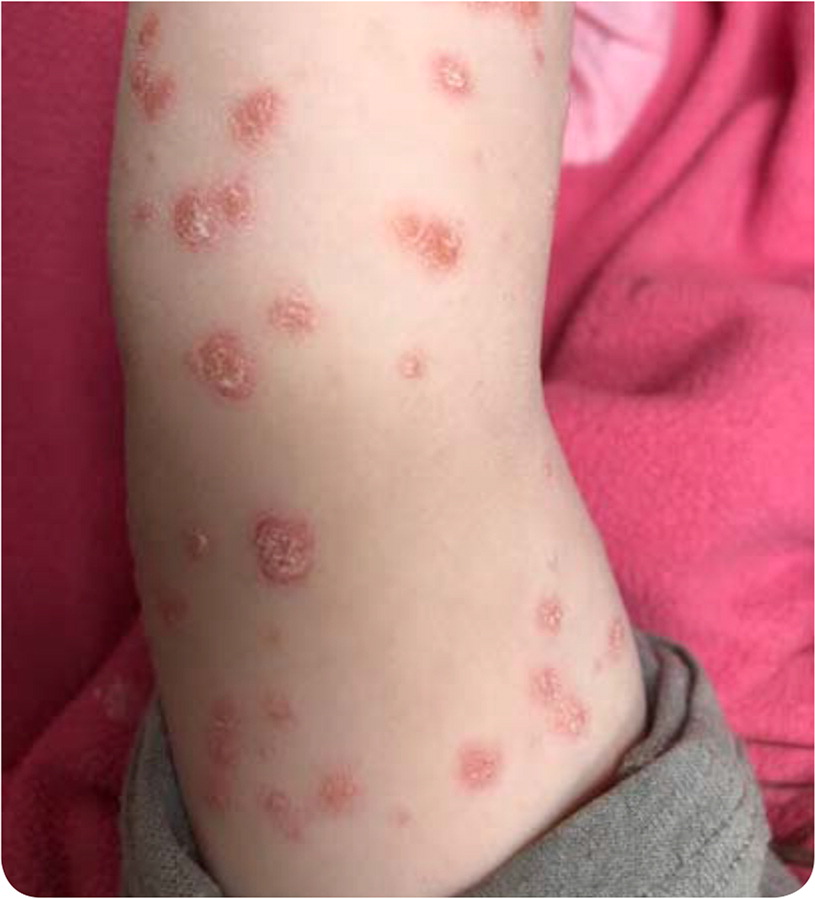
New-Onset Full-Body Rash Following Sore Throat in a Child
Am Fam Physician. 2019;99(9):575-576
Author disclosure: No relevant financial affiliations.
A five-year-old girl presented with a new-onset, full-body, pruritic rash. Treatment at home before presentation to the clinic included topical antibiotic cream with no improvement. The patient had a sore throat about one week before the rash appeared but was otherwise asymptomatic. She had no significant medical history, and her vaccinations were up to date.
Physical examination revealed numerous small, erythematous plaques covering the bilateral arms, legs, chest, abdomen, back, face, and scalp (Figure 1 and Figure 2). The rash spared the palms and soles. No excoriations were present. Rapid testing was negative for streptococcal infection. The antistreptolysin O titer was 892 IU per mL.


Question
Discussion
The answer is A: guttate psoriasis. Guttate psoriasis accounts for less than 2% of psoriasis cases.1 Between 56% and 97% of new-onset guttate psoriasis cases are preceded by a streptococcal infection, typically by two to three weeks2; however, the condition may be chronic and unrelated to streptococcal infection. Guttate psoriasis often spontaneously resolves after a few weeks. Persistent lesions can be treated with exposure to sunlight and topical corticosteroids. Antibiotics can be added if throat culture is positive for beta-hemolytic streptococcus. Guttate psoriasis is most often diagnosed in children and in adults younger than 30 years.
Diagnosis of guttate psoriasis is based on clinical presentation, although biopsy can be performed for difficult cases. The condition is characterized by an acute eruption of numerous small, teardrop-shaped, erythematous papules and plaques throughout the body. Laboratory testing may be considered if signs or symptoms of streptococcal pharyngitis are present.
Nummular eczema is a chronic, pruritic, inflammatory dermatitis that most commonly occurs in older children and adolescents. The vesicular and papular lesions are typically closely grouped, joining together to form plaques. The lesions are usually round or coin shaped, and dull red to dark in color or hyperpigmented. Nummular eczema usually manifests on the extensor surfaces of the hands, arms, and legs.3
Pityriasis rosea typically presents as a herald patch that is 2 to 5 cm in size. The herald patch is followed by multiple 5-mm to 3-cm round to oval patches that form a “Christmas tree” pattern. Typically, the lesions develop on the trunk and proximal extremities. Lesions on the head and face are not common in adults but may be present in children.4
Tinea corporis commonly presents as round, pink plaques with small peripheral papules and a rim of scales, usually on the neck and back.3 The plaques typically have an area of central clearing. Diagnosis can be confirmed with identification of the fungus under microscopy using a potassium hydroxide preparation.

| Condition | Characteristics |
|---|---|
| Guttate psoriasis | Acute eruption of numerous small, teardrop-shaped, erythematous papules and plaques throughout the body |
| Nummular eczema | Closely grouped vesicles and papules that form plaques; round or coin shaped; dull red to dark in color or hyperpigmented; typically located on extensor surfaces of hands, arms, and legs |
| Pityriasis rosea | Herald patch followed by multiple round to oval patches in a “Christmas tree” pattern; typically located on the trunk and proximal extremities |
| Tinea corporis | Round, pink plaques with small peripheral papules and a rim of scales; plaques usually have an area of central clearing; typically located on the neck and back |

